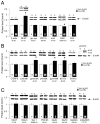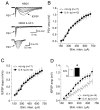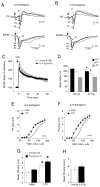Altered synaptic transmission in the hippocampus of transgenic mice with enhanced central nervous systems expression of interleukin-6
- PMID: 22609298
- PMCID: PMC3427030
- DOI: 10.1016/j.bbi.2012.05.005
Altered synaptic transmission in the hippocampus of transgenic mice with enhanced central nervous systems expression of interleukin-6
Abstract
Elevated levels of the inflammatory cytokine interleukin-6 (IL-6) occur in a number of CNS disorders. However, little is known about how this condition affects CNS neuronal function. Transgenic mice that express elevated levels of IL-6 in the CNS show cognitive changes, increased propensity for hippocampal seizures and reduced number of inhibitory interneurons, suggesting that elevated levels of IL-6 can cause neuroadaptive changes that alter hippocampal function. To identify these neuroadaptive changes, we measured the levels of protein expression using Western blot analysis and synaptic function using field potential recordings in hippocampus from IL-6 transgenic mice (IL-6 tg) and their non-transgenic (non-tg) littermates. Western blot analysis showed enhanced levels of the GFAP and STAT3 in the IL-6 tg hippocampus compared with the non-tg hippocampus, but no difference for several other proteins. Field potential recordings of synaptic transmission at the Schaffer collateral to CA1 synapse showed enhanced dendritic excitatory postsynaptic potentials and somatic population spikes in the CA1 region of hippocampal slices from IL-6 tg mice compared with slices from non-tg littermate controls. No differences were observed for several forms of short-term and long-term synaptic plasticity between hippocampal slices from IL-6 tg and non-tg mice. These results demonstrate that elevated levels of IL-6 can alter mechanisms involved in the excitability of hippocampal neurons and synapses, an effect consistent with recent evidence indicating that elevated production of IL-6 plays an important role in conditions associated with seizure activity and in other impairments observed in CNS disorders with a neuroinflammatory component.
Copyright © 2012 Elsevier Inc. All rights reserved.
Figures







References
-
- Akira S, Hirano T, Taga T, Kishimoto T. Biology of multifunctional cytokines: IL-6 and related molecules (IL-1 and TNF) FASEB Journal. 1990;4:2860–2867. - PubMed
-
- Andreasen M, Hablitz JJ. Paired-pulse facilitation in the dentate gyrus: a patch-clamp study in rat hippocampus in vitro. J Neurophysiol. 1994;72:326–336. - PubMed
-
- Andressen C, Blumcke I, Celio MR. Calcium-binding proteins: selective markers of nerve cells. Cell Tissue Res. 1993;271:181–208. - PubMed
-
- Balschun D, Wetzel W, Del Rey A, Pitossi F, Schneider H, Zuschratter W, Besedovsky HO. Interleukin-6: a cytokine to forget. FASEB Journal. 2004;18:1788–1790. - PubMed
Publication types
MeSH terms
Substances
Grants and funding
LinkOut - more resources
Full Text Sources
Molecular Biology Databases
Miscellaneous

